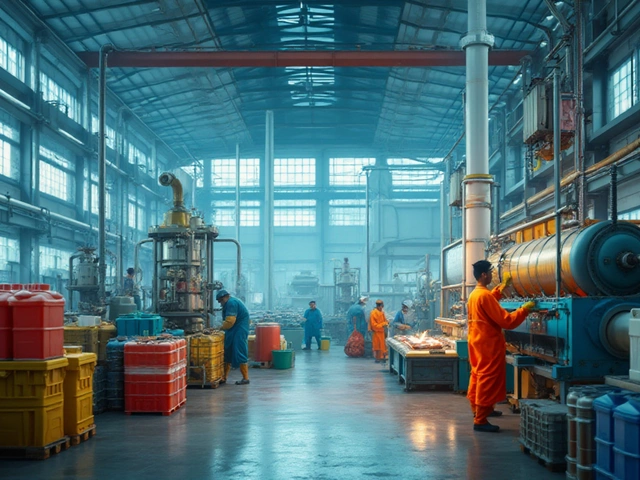Indian pharma manufacturers, often hailed as the 'pharmacy of the world', are grappling with challenges that could risk their global standing. They are dealing with strict regulations, quality control issues, and cutting-edge competition. Ever wondered how they manage all these hurdles? Let's delve deeper.
Firstly, keeping up with regulatory compliance is like walking on a tightrope. The rules are complex, and they change frequently. Manufacturers must stay updated to avoid potentially costly penalties. But is it just about following rules, or is there more at stake? Compliance is also deeply linked to quality assurance.
Quality is where the real test lies. Ensuring every pill is safe and effective isn't just good practice; it's mandatory. Even a slight slip can have disastrous consequences for patient safety and a company's reputation. This constant vigil is a resource-heavy endeavor but absolutely crucial.
- Regulatory Compliance and Its Complexities
- Quality Control: A Top Priority
- Fierce Global Competition
- Embracing Technological Advancements
- Navigating Sustainability Challenges
Regulatory Compliance and Its Complexities
In the world of Indian pharma, navigating the maze of regulations is no small feat. Compliance isn't just about following set rules—it's about aligning with evolving standards imposed by bodies like the CDSCO in India or even the FDA for those targeting the US market. The challenge is real, and it's more urgent than ever.
Understanding the Regulatory Framework
The Central Drugs Standard Control Organization (CDSCO) is the primary regulatory authority in India. It ensures that drugs are safe and effective. Indian manufacturers must meet stringent standards at every step, from research and development to the finished product. Failure isn't an option here; non-compliance can lead to legal troubles and substantial financial losses.
Moreover, international markets come with their own sets of rules. The European Medicines Agency (EMA) and the United States Food and Drug Administration (FDA) have their unique compliance requirements. Achieving approval is often seen as a badge of credibility, especially important when exporting to developed nations.
Core Challenges
- Documentation: Massive amounts of documentation are needed to demonstrate compliance. It's a continuous process requiring meticulous attention to detail.
- Quality Assurance: Meeting quality norms isn't just desirable but mandatory. Indian pharma companies must invest in robust quality management systems to maintain their competitive edge.
- Frequent Updates: Regulations change frequently, and companies need to stay agile. Keeping teams trained and updating processes are ongoing necessities.
| Regulatory Body | Region | Key Focus |
|---|---|---|
| CDSCO | India | Drug safety and efficacy within India |
| FDA | United States | Food and drug safety, effective manufacturing practices |
| EMA | European Union | High standards for medicinal product approval |
By recognizing these challenges, Indian pharma manufacturers can prepare themselves better to adapt and thrive. It requires more than just resources; it demands a strategic approach and relentless commitment to setting global standards.
Quality Control: A Top Priority
When it comes to Indian pharma manufacturers, quality control isn't just another box to tick—it's the heart of the operation. Ensuring that every single product meets safety and efficacy standards is non-negotiable. But how do these companies manage such a massive responsibility?
Setting the Standards
The first step in maintaining world-class quality is understanding the standards set by global health authorities like the FDA and WHO. These bodies have stringent criteria, and Indian manufacturers need to ensure their processes and products align with these guidelines. It’s not about meeting expectations; it’s about exceeding them.
Regular Audits and Inspections
To maintain these standards, regular audits and inspections are crucial. These evaluations help identify any shortfalls in the manufacturing process, allowing timely corrective actions. It's a continuous cycle of improvement, where even minor details matter.
Advanced Technology in Quality Control
Using advanced technology like AI-driven analytics and IoT can significantly enhance the quality control process. These technologies help in monitoring and analyzing every stage of production, ensuring consistency, reducing human error, and optimizing operations.
Training and Development
Employee training plays a crucial role here. The workforce must be well-versed in the latest quality control methodologies. Regular workshops and training sessions are important to keep the workers updated about new techniques and compliance requirements.
Remember, the real challenge isn't just meeting the standards—it's maintaining them consistently over time. For pharma industry India, where the stakes are incredibly high, this ongoing commitment to quality can set them apart in a fiercely competitive market.

Fierce Global Competition
The Indian pharma industry isn't just competing with local players; it's facing tough rivals globally. Why? Well, Big Pharma giants in the U.S. and Europe are always looking for ways to maintain their market share, while markets like China are rapidly advancing, posing even more challenges.
One notable insight comes from a discussion by the Indian Pharmaceutical Alliance, which highlighted how Indian manufacturers aren't just competing on price but also on innovation and quality. A spokesperson noted,
"The focus has shifted from merely being affordable to being innovative and reliable, which is crucial for sustaining global competitiveness."
Moreover, research and development (R&D) are becoming vital. The industry is seeing increased pressure to invest in R&D to create new drugs that meet the evolving needs of patients worldwide. But there's a catch. Investing in R&D is financially intensive and risk-laden, especially when smaller firms are trying to make a mark against well-established companies.
Leveraging Certifications
Another tactic to stand tall in the global market is acquiring international certifications. Good Manufacturing Practice (GMP) certification, for instance, isn't just a badge of honor; it's a ticket to entering and staying in stringent markets like the U.S. and Europe.
Notably, as per a recent report, around 20% of the world’s generics by volume come from India, underscoring India's vital role in the pharma world. However, maintaining this share amidst global supply chain disruptions and raw material shortages is no small feat.
Building alliances and partnerships can also help Indian companies gain a competitive edge. By sharing resources or collaborating on R&D, they can reduce costs, improve innovation, and access new markets. Are Indian firms ready to team up to tackle these challenges head-on?
Embracing Technological Advancements
In the ever-evolving world of pharmaceuticals, technology stands as both a challenge and an opportunity. For Indian pharma manufacturers, embracing tech innovations isn't an option anymore—it's practically mandatory.
Why Go Digital?
Going digital is no longer just about being trendy. With the right tech, companies can streamline operations, reduce human errors, and increase efficiency. The use of AI and machine learning in manufacturing processes helps in predicting equipment failures and enhancing the quality control processes. Did you know some companies are seeing up to a 30% reduction in production downtime with these tools?
Data And Automation
Data-driven decision-making is crucial. By leveraging data analytics, manufacturers can gain insights into production cycles, optimize supply chain management, and foresee demand fluctuations. Automation, on the other hand, can significantly cut costs and speed up production—giving those who adopt it a competitive edge in the global competition.
Blockchain for Transparency
Trust is paramount in pharma. Blockchain technology ensures transparency and traceability throughout the supply chain, from raw materials to the final product. It's a powerful way to fight the counterfeit drug market, which, as per recent estimates, accounts for more than 10% of the global drug market.
Virtual Reality and Training
On the human side, VR technologies are revolutionizing staff training by providing real-world scenarios without the risk. This way, employees get hands-on experience in a controlled environment, enhancing their skills and ensuring they're ready for on-the-job challenges.
While these technologies require initial investment, the long-term gains—like improved compliance, quality, and efficiency—far outweigh the costs. For pharma manufacturers in India, leveraging technology is a surefire way to stay ahead of the curve.

Navigating Sustainability Challenges
In the arena of Indian pharma, sustainability isn't just a buzzword; it's a necessity. Manufacturers are under pressure to produce medicines not only efficiently but also responsibly. So, what's the big deal, and how are they managing it?
Cutting Down on Environmental Impact
One of the biggest challenges is minimizing the carbon footprint that comes with making pharmaceuticals. Imagine the energy costs and waste outputs involved. The goal is to bring them down. Companies are now investing in greener technologies like using renewable energy sources to power their manufacturing plants. This not only helps in reducing emissions but also brings long-term cost benefits.
Efficient Waste Management
Another tricky area is waste management. The process of making medicines generates a hefty amount of waste. From chemical by-products to packaging, it's a lot to deal with. Some firms are implementing robust waste recycling programs to tackle this issue. By segregating waste effectively, they can recycle and reduce the amount heading to landfills.
Moreover, an interesting trend is emerging with 'green chemistry'. This approach focuses on reducing or even eliminating hazardous substances in production. Still a developing field, it's gaining traction for its potential to make pharma manufacturing both safer and more efficient.
Sustainable Sourcing and Supply Chain
There's also the question of how ingredients are sourced. Sustainable sourcing ensures the raw materials used don't harm the environment and support fair labor practices. This idea is catching on, with many companies re-evaluating their supply chains to align with sustainability goals.
| Challenge | Solution |
|---|---|
| Energy Use | Adopt renewable sources |
| Waste Production | Recycling and green chemistry |
| Sourcing | Ensure fair and eco-friendly practices |
Tackling these challenges isn't just about corporate responsibility; it's a chance to stand out globally. By leaning into eco-friendly methods, Indian pharma manufacturers can not only improve their image but also tap into growing markets that prioritize sustainability.





